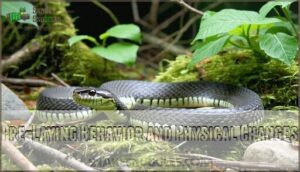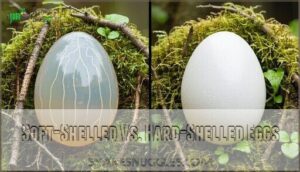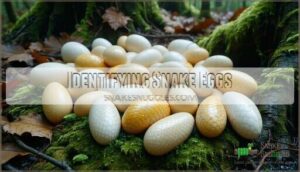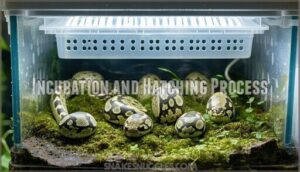This site is supported by our readers. We may earn a commission, at no cost to you, if you purchase through links.

About 70% of snake species are oviparous, meaning they lay soft-shelled eggs like Ball Pythons and Corn Snakes.
However, roughly 30% give live birth instead, with Boas and most vipers being viviparous, delivering fully formed babies.
Rattlesnakes are ovoviviparous – they carry eggs internally until hatching, then birth live young.
This reproductive flexibility helps snakes thrive in different environments, from humid tropics perfect for egg incubation to cooler climates where internal development offers better temperature control.
The timing, location, and care involved in snake reproduction involves fascinating adaptations you’ll want to explore.
Table Of Contents
- Key Takeaways
- Snake Reproduction Basics
- Where and When Snakes Lay Eggs
- How Snakes Lay Eggs
- Viviparous and Ovoviviparous Snakes
- Snake Egg Identification and Care
- Frequently Asked Questions (FAQs)
- Do snakes lay eggs or give birth?
- Do elapid snakes lay eggs?
- What snakes do not lay eggs?
- Do snakes give birth or lay eggs?
- How do you identify a snake egg?
- Where do snakes go to lay eggs?
- Do all female snakes lay eggs at the same age?
- Can snakes reproduce without mating with a male snake?
- How do snakes determine the sex of their offspring?
- Can snakes breed and lay eggs in captivity successfully?
- Conclusion
Key Takeaways
- Most snakes are egg-layers, but not all – About 70% of snake species lay soft-shelled eggs, while 30% give birth to live young through different reproductive methods
- You’ll find three distinct reproductive strategies – Snakes either lay eggs (oviparous), give live birth (viviparous), or hatch eggs internally before birthing live young (ovoviviparous)
- Environmental factors determine reproductive success – Temperature, humidity, and food availability control when snakes breed, where they nest, and how many offspring they produce
- Snake eggs need specific care conditions – If you find snake eggs, they require consistent temperatures of 80-84°F and 90% humidity for successful hatching over 45-90 days
Snake Reproduction Basics
You’ll find that most snakes reproduce by laying eggs, but the process varies more than you might expect.
Snake reproduction involves three main methods: egg-laying (oviparity), live birth (viviparity), and a combination approach where eggs hatch inside the mother before birth (ovoviviparity).
Types of Snake Reproduction
Three main types of snake reproduction exist, each with unique characteristics. Oviparous snakes lay soft-shelled eggs that develop externally, representing about 70% of all snake species like Ball Pythons and Corn Snakes. Viviparous snakes give birth to live young after nourishing embryos internally, including Boas and Anacondas. Ovoviviparous snakes hatch eggs inside their bodies before delivering live offspring, like Rattlesnakes.
Snake species employ these varied survival strategies to guarantee their continuation.
- Oviparity Details: Soft, leathery eggs require external incubation for 40-70 days
- Viviparity Traits: Direct nourishment creates fully developed babies at birth
- Ovoviviparity Facts: Internal egg hatching combines benefits of both methods
- Parthenogenesis allows some females to reproduce without males through sperm storage
Factors Affecting Snake Reproduction
Several factors influence snake reproduction success.
Smart snakes know the secret: timing, temperature, and territory determine reproductive triumph
Dietary Influence affects egg quality – well-fed females produce healthier clutches.
Temperature and humidity create favorable breeding conditions, while Genetic Diversity guarantees viable offspring.
Climate Change and Habitat Loss disrupt natural cycles, and Pollution Impact can reduce fertility rates in wild populations.
| Factor | Impact on Reproduction |
|---|---|
| Diet & Health | Determines egg quality and clutch size |
| Environmental Conditions | Controls breeding timing and success rates |
| Human Activities | Affects habitat availability and genetic diversity |
Age of Sexual Maturity in Snakes
Looking at snake reproduction, you’ll find sexual maturity varies substantially by species variation.
Most snakes mature between 2-3 years, but growth rate matters more than age.
Environmental impact and captivity effects accelerate development through consistent feeding.
Ball pythons need 2-3 years while corn snakes mature faster at 18-36 months, showing how breeding season timing depends on individual snake reproduction readiness.
Understanding snake reproductive anatomy is essential for successful breeding.
Environmental Factors Influencing Breeding
Once snakes reach breeding age, environmental conditions become the deciding factor for successful reproduction.
Your local climate directly affects when and how often snakes breed, with temperature species responding differently to seasonal changes.
Environmental conditions that influence snake breeding include:
- Temperature Impact: Cooler breeding seasons delay mating, while warmer incubation periods speed up egg development
- Prey Availability: Well-fed females produce larger clutches during abundant food seasons
- Habitat Loss: Urban development forces snakes into suboptimal nesting sites, reducing reproductive success
Climate change and pollution effects increasingly disrupt traditional mating season timing across species.
Where and When Snakes Lay Eggs
When you’re dealing with oviparous snakes, you’ll find they’re quite selective about where they deposit their precious cargo.
These reptiles typically choose warm, humid locations like rotting logs, leaf piles, or soft soil that provide protection and stable temperatures for their developing offspring.
Choosing a Nesting Site
Selecting the perfect nesting site requires careful consideration of multiple environmental factors.
Egg laying snakes prioritize locations with ideal substrate like rotting logs or loose soil that provide temperature control and proper humidity levels.
These nesting sites must offer nest protection from predators while ensuring site availability during breeding season.
Female snakes evaluate each potential location’s microclimate before committing to their egg laying behavior, which is crucial for the survival of the species and requires a suitable nesting site.
Timing of Egg-Laying
After mating, female snakes typically begin egg laying two to four weeks later, though sperm storage allows some species to delay this process for months.
Seasonal laying peaks between April and June when temperature effects create favorable conditions for egg development.
Most egg laying snakes time their reproduction to coincide with warmer weather, guaranteeing successful incubation and hatching when food sources are abundant for their offspring.
To guarantee proper egg development, some breeders utilize a reptile egg incubator.
Clutch Size Variation by Species
When you consider clutch size, snake species show remarkable variation that depends on Genetic Factors, Maternal Health, and Environmental Impact.
Some egg laying snakes produce just a few eggs, while others create massive clutches:
- Crown snakes typically lay around 3 small snake eggs per clutch
- Corn snakes produce medium clutches of 10-30 eggs with consistent egg shape
- Large pythons can lay up to 46 eggs, with mud snakes reaching 111 eggs
Food Availability and Species Survival strategies influence these numbers substantially across different snake species.
Some snakes have adapted to live birth strategies in colder climates.
Breeding Season and Environmental Factors
Seasonal Triggers like temperature and daylight changes prompt most snake reproduction cycles.
Geographic Variation means temperate species typically breed from May to August, while tropical snakes mate year-round.
Climate Impact is shifting these patterns, forcing Conservation Concerns as environmental conditions affect mating season timing and Nesting Behavior for successful egg laying.
How Snakes Lay Eggs
When you find snake eggs, you’ll notice they’re white or cream-colored with a soft, leathery shell that feels completely different from bird eggs.
The egg-laying process involves the female snake releasing eggs one at a time through her cloaca, with each egg already having its flexible shell formed inside her body.
Pre-Laying Behavior and Physical Changes
Before laying eggs, female snakes show clear pre-laying behaviors that indicate egg formation is nearly complete.
You’ll notice reduced appetite as her body prioritizes energy for the final stages of egg development. Body swelling becomes more pronounced around the midsection where eggs are positioned.
Many females exhibit restless behavior and strong nesting urges, actively searching for suitable sites. The shedding cycle often coincides with this period, as hormonal changes affect skin renewal.
Shell glands work overtime during these final days, completing the leathery coating around each egg before the laying process begins. Some species create permeable, leathery shells for their eggs, which is a critical aspect of egg formation and laying process.
Egg Expulsion and Shell Formation
After pre-laying behavior completes, the actual egg formation process begins inside the female’s reproductive system.
Here’s what happens during egg expulsion and shell formation:
- Oviduct contractions push each egg through the reproductive tract, while shell glands add protective layers around the developing embryo.
- Calcium deposition creates the leathery shell structure, with egg pigmentation determining the final coloration you’ll observe.
- Expulsion timing varies by species, but most snakes complete egg laying within several hours of the process starting.
Soft-Shelled Vs. Hard-Shelled Eggs
Snake eggs come with two main shell composition types that affect their survival strategies.
Most snake eggs feature leathery shells made of flexible proteins, allowing excellent egg permeability for gas exchange and meeting hydration needs through moisture absorption.
Hard-shelled eggs are rare in snakes, offering superior protection but limiting flexibility.
These incubation differences reflect evolutionary advantages – soft shells adapt to humid environments while hard shells resist desiccation and damage.
Post-Laying Behavior and Egg Care
Once you’ve watched your snake lay her eggs, the real drama begins. Most snakes abandon their clutches immediately, leaving eggs to fend for themselves in their chosen nesting spots.
However, some species show remarkable maternal care:
- Python mothers coil around their eggs for weeks, maintaining ideal incubation temperatures through muscle contractions
- King cobras build elaborate nests from vegetation and guard them fiercely until hatchling emergence
- Some rattlesnakes stay near abandoned clutches, providing limited nest defense against predators
- Temperature-sensitive species may adjust their coiling behavior based on environmental conditions affecting incubation needs
Egg incubation success depends heavily on consistent humidity and warmth, whether through parental care or environmental factors. For those without parental care, consider using a snake egg incubator to guarantee proper development.
Viviparous and Ovoviviparous Snakes
While most snakes lay eggs, you’ll find that some species have evolved different approaches to reproduction.
About 30% of snake species give birth to live young through either viviparity or ovoviviparity, allowing them to better protect their offspring in challenging environments.
Characteristics of Live-Bearing Snakes
While many snakes lay eggs, viviparous snakes completely skip this step by developing babies inside their bodies.
Ovoviviparous snakes take a middle approach, forming eggs that hatch internally before birth.
Here are the key traits of livebearing snakes:
- Extended gestation period – Viviparous snakes carry young for months with placental nourishment
- Higher maternal investment – Mothers provide direct nutrition and protection during development
- Variable litter sizes – Live young births range from just a few to dozens of offspring
Advantages of Live Birth
Live birth offers viviparous snakes distinct advantages over egg-laying species.
You’ll find these livebearing snakes thrive in cooler climates where ground temperatures can’t support egg development. Their young emerge fully formed and ready to hunt, eliminating vulnerable incubation periods.
| Live Birth Benefits | Adaptive Advantage |
|---|---|
| Temperature Control | Mother regulates body heat for developing young |
| Predator Protection | No exposed eggs vulnerable to threats |
| Neonate Survival |
Higher success rates in harsh environments.
This reproductive success stems from maternal care during gestation. Ovoviviparous species particularly benefit, as eggs develop safely within the mother’s body. The result? Better survival odds for live young compared to their egg-laying cousins.
Examples of Viviparous and Ovoviviparous Snakes
You’ll find fascinating examples among viviparous snakes like boa constrictors and garter snakes, which nourish embryos through placenta-like structures.
Ovoviviparous species include rattlesnakes and copperheads that retain eggs internally until hatching.
These reproductive modes showcase nature’s adaptability, with live birth strategies evolving in colder climates where external incubation proves challenging for snake development.
Understanding viviparous snake characteristics is essential for learning about their unique biology and viviparous species habits.
Birthing Process in Live-Bearing Snakes
When you’re watching viviparous snakes or ovoviviparous snakes approach delivery, you’ll notice distinct behavioral changes that signal live birth is near.
The birthing process in these live-bearing species follows predictable patterns that differ substantially from egg-laying reproductive methods.
Here’s what happens during the birthing process:
- Pre-birth restlessness – The female becomes agitated and may refuse food as fetal development completes
- Body contractions – Muscular waves help push live young through the birth canal during the gestation period’s end
- Sequential delivery – Neonates emerge one at a time, often still enclosed in thin membranes
- Immediate independence – Newborns receive no neonate care and must fend for themselves immediately
- Post-birth recovery – The exhausted mother resumes normal behavior within hours, unlike species with snake placenta systems
Snake Egg Identification and Care
If you find what looks like snake eggs in your yard, you’ll want to identify them correctly before deciding what to do next.
Snake eggs have distinct characteristics that set them apart from bird eggs, and knowing how to care for them properly can mean the difference between successful hatching and failed development, which is crucial for successful hatching.
Identifying Snake Eggs
When you encounter snake eggs, identifying them correctly helps determine the species.
Snake eggs have distinctive characteristics that set them apart from bird eggs or other reptile eggs.
| Feature | Snake Egg Characteristics |
|---|---|
| Shell Texture | Soft, leathery, pliable (not hard like bird eggs) |
| Shape | Elongated, oval, or oblong |
| Colors | White, cream, beige, yellow, or gray |
| Size Range | Few centimeters to 10+ cm long |
| Arrangement | Found in clusters or clutches |
Snake egg identification starts with examining the shell texture – they’re always soft and rubbery, never hard.
Egg shape variations include elongated ovals, while snake egg colors range from pure white to cream or beige.
These egg shell types allow moisture exchange during development, unlike rigid bird eggs.
Understanding egg incubation methods is vital for the successful hatching of snake eggs.
Incubation and Hatching Process
Once you’ve identified those snake eggs, proper incubation becomes your priority.
Maintaining temperature control between 80-84°F and humidity management around 90% guarantees successful development. Most species require 45-90 days for hatching.
During this period, egg monitoring reveals changes in shell texture and color, signaling approaching hatch time.
Key Incubation Methods:
- Container Setup – Use plastic containers with ventilation holes inside insulated boxes
- Temperature Control – Maintain consistent heat using thermostats and heating elements
- Humidity Management – Keep substrate slightly moist, never soaking wet
- Egg Monitoring – Check weekly for mold, dimpling, or other developmental changes
Care and Survival of Hatchlings
Once your snake eggs hatch, hatchling snakes need immediate attention for survival.
These tiny baby snakes require proper Hatchling Nutrition within 7-10 days—offer appropriately sized prey like pinkie mice.
Neonate Care involves maintaining ideal temperatures and humidity in their Hatchling Environment.
Keep each hatchling separately to prevent competition and stress.
Monitor for signs of illness or difficulty shedding.
Newborn Survival depends on your consistent care during these critical first weeks.
Common Challenges in Snake Egg Care
Caring for snake eggs successfully requires addressing several key challenges.
Humidity control proves critical, as levels below 70% cause desiccation while excess moisture fosters fungal infections affecting 30% of clutches.
Egg temperature must stay between 25-31°C, with fluctuations extending incubation timing by 10-15 days.
Proper nesting materials prevent contamination, while avoiding egg rotation maintains embryo orientation.
Monitor for mold growth and predators throughout snake egg incubation.
Frequently Asked Questions (FAQs)
Do snakes lay eggs or give birth?
Most snakes lay eggs, but it’s not that simple. You’ll find three methods: egg-laying (70% of species), live birth like garter snakes, and internal egg-hatching like rattlesnakes.
Do elapid snakes lay eggs?
Most elapid snakes, including cobras, mambas, and coral snakes, are oviparous and lay eggs. They’ll deposit clutches of leathery-shelled eggs in warm, protected spots for incubation.
What snakes do not lay eggs?
Viviparous and ovoviviparous species don’t lay eggs. You’ll find garter snakes, boa constrictors, and rattlesnakes give live birth instead. About 30% of snake species skip egg-laying entirely.
Do snakes give birth or lay eggs?
Both—it depends on the species! You’ll find that roughly 70% of snakes lay eggs (oviparous), 20% give live birth (viviparous), and 10% hatch eggs internally before birthing live young (ovoviviparous).
How do you identify a snake egg?
You’ll recognize snake eggs by their soft, leathery texture and elongated shape. They’re white or cream-colored, found in clusters, and feel rubbery unlike hard bird eggs.
Where do snakes go to lay eggs?
Snakes seek warm, humid, sheltered spots like under rocks, logs, or dense vegetation.
You’ll find eggs in compost piles, abandoned burrows, decaying wood, or leaf litter where incubation conditions are ideal.
Do all female snakes lay eggs at the same age?
Like teenagers hitting growth spurts at different times, female snakes don’t all reach sexual maturity simultaneously.
Age varies substantially by species, with some reaching maturity at two years while others need five or more years before they’re ready to reproduce.
Can snakes reproduce without mating with a male snake?
Yes, you’ll find that some female snakes can reproduce without mating through parthenogenesis. This process creates genetic clones and occurs in boas, pythons, and rattlesnakes when males aren’t available.
How do snakes determine the sex of their offspring?
Mother Nature doesn’t let you choose your baby snake’s sex – it’s all about temperature.
Most species use temperature-dependent sex determination, where warmer incubation creates females and cooler temperatures produce males.
Can snakes breed and lay eggs in captivity successfully?
Yes, you can successfully breed and lay eggs in captivity with proper setup.
You’ll need controlled temperature (27-31°C), high humidity (90%), suitable nesting boxes, and healthy, mature snakes for ideal results, which involves proper setup.
Conclusion
Understanding the snake world is like opening a reptilian treasure chest filled with fascinating reproductive strategies.
Whether you’re wondering "do snakes lay eggs" for a school project or considering snake ownership, you now know that most snakes are egg-layers, while others give live birth.
Each method represents millions of years of evolutionary adaptation to specific environments.
From the careful nest selection of pythons to the internal development in vipers, these reproductive strategies showcase nature’s incredible flexibility and innovation in ensuring species survival.
- https://www.sciencedirect.com/topics/earth-and-planetary-sciences/oviparity
- https://www.nwf.org/Educational-Resources/Wildlife-Guide/Reptiles/Rattlesnakes
- https://www.discoverwildlife.com/animal-facts/reptiles/how-do-snakes-mate
- https://wildlifewaystation.org/animals/species/python-burmese
- https://nationalzoo.si.edu/animals/king-cobra
















